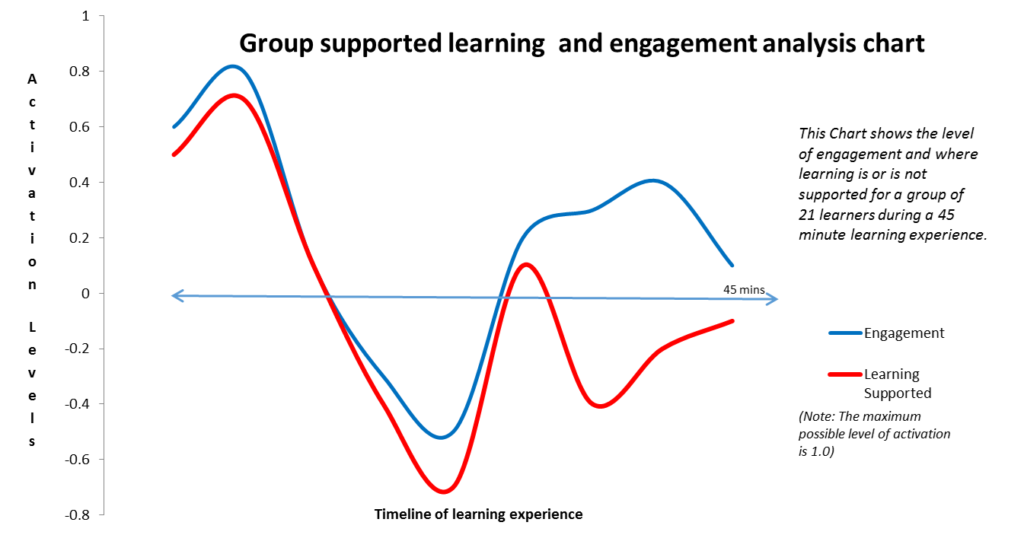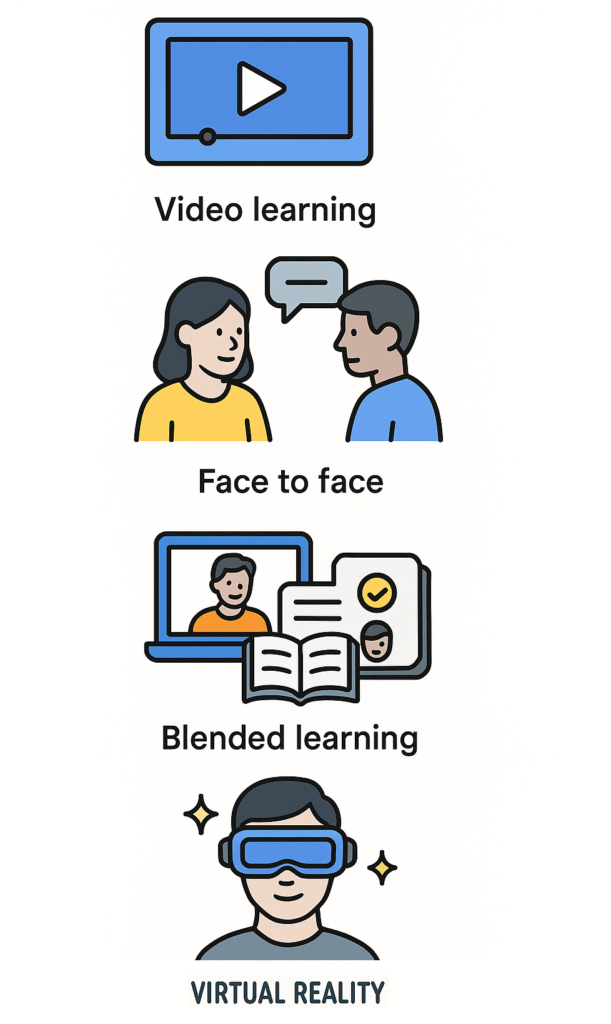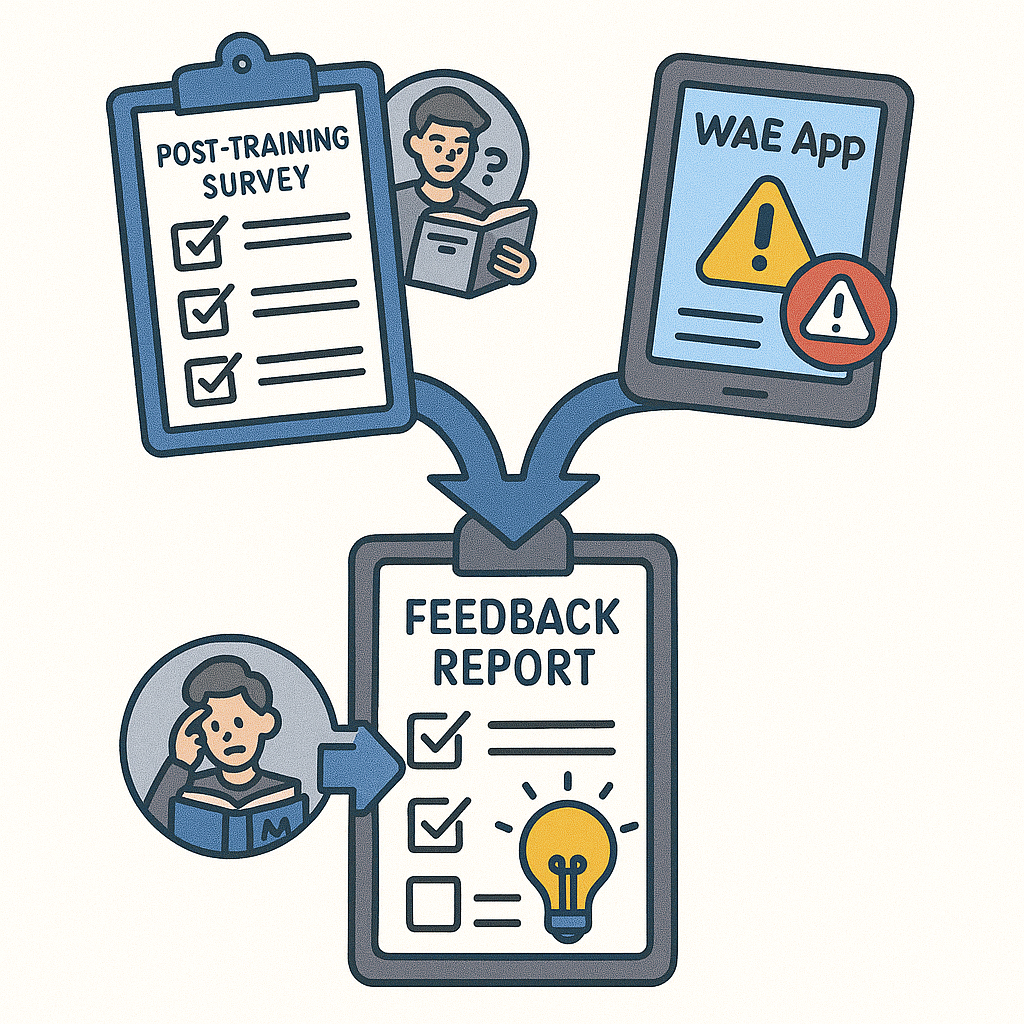The WAE App
The WAE app analyses learning content and delivery methods to assess engagement and effectiveness, providing science-based strategies to optimise both.
A new App to analyse and improve your training content and delivery
Imagine an application capable of analysing your learning content and delivery methods for engagement and effectiveness in supporting learning. Then generating science-based strategies to optimise both the content and the delivery.

The graph above illustrates the results from a sampled cohort of learners utilising the WAE App version designed for film-based scenario learning. The version developed for both online and face-to-face learning encompasses only four categories: Enjoyment/ Focus, Frustration, Boredom, and Relaxation.

The graph above draws from the raw data and illustrates learning and engagement patterns. It is important to note that engagement levels can remain high even when the learning content does not effectively support learning. The WAE App offers an optimal solution for enhancing learning opportunities. In the given example, the WAE App would recommend adjustments to the content or method to elevate the supported learning curve.
The WAE App can function as a tool as part of a comprehensive review process that includes traditional post training surveys.
Consider the satisfaction of your learners and clients, knowing that the learning content they receive has been assessed by a science-based tool designed to promote engagement and support effective learning!
How the WAE App works
The WAE app samples learners’ academic and other emotions at pre-determined points during a learning session. Using a simple interface that does not distract from their learning focus. The WAE App, works on phones and tablets and laptops.
The process of using the WAE App is:

The WAE App has been peer-reviewed as part of an academic study and tested in Vocational (VET), corporate and higher education settings, where learning content has been a mixture of face-to-face, video and role-play activities.
The WAE App produces a comprehensive report illustrating exactly where and when in a training session engagement and learning were and were not supported. This PDF report includes strategies for directly addressing weaknesses in the training, providing a clear pathway optimisation pathway.

Learning Modalities and the Science
Learning modalities
Video learning, face to face, blended learning and virtual reality learning are all examples of learning modalities. How learning occurs is dependent upon the way knowledge is presented to the learner. The WAE App, has been designed to accommodate these differences, the results of trials have resulted in different configurations matched to each modality.
Science
The overarching theory that drives the WAE App is that of Academic emotions (Pekrun, Goetz, Titz & Perry, 2002), Filmic emotions (Smith,1999) and the those unique to Virtual Reality (Hall, 2019).
These theories posit that bored, relaxed and disengaged learners struggle to learn from any content no matter what the modality.
Individuals who enjoy their learning experience and remain focused are more likely to achieve deep learning. While a certain level of frustration can also promote learning—consider the challenge of solving a difficult puzzle—excessive frustration or content that elicits overly strong emotions lead to disengagement. This is evident in “shock advertisements,” for example those for road safety, where graphic crash scenes intended to influence driver behaviour often cause viewers to turn away, ceasing to watch or listen.
These concepts have been incorporated into the WAE App.

The WAE App for Training Administrators
The WAE App is a great tool for training administrators and can be used for the following:
Trainer evaluations
Traditional post training evaluations and surveys are very dependent upon the relationship between the learners and the trainer, so often do not produce reliable, actionable results. Using the WAE App highlights how a trainer is ensuring learner engagement and where they might need to improve parts of their delivery to support learning. The WAE App solely focuses on delivery and content not on other aspects which distract from reliable reporting.
The suggested use is of both a post training session survey and using the WAE App as part of a learning session the trainer has delivered, these data sources combined to complete the Trainers feedback.
Diagnostics
Often trainer evaluations if done well will point to problems with trainer resources or a trainer not knowing how to make a training program engaging. Using the WAE App as a diagnostic tool will highlight problems with content and delivery, it will suggest changes to that will overcome the problematic areas of delivery and content highlighted.
The use of the WAE App often confirms what trainers already know but are unable to report due to a variety of reasons.

The WAE App for learning Content Creators
The WAE App is ideal for content creators, not just learning content as it also illustrates engagement. Once sampling has been completed the content creator can review the learning trace and strategies then amend the content to support learning.
Content creators can have confidence their content will both engage their target cohort and foster learning.

